Advancing Antibiotic Residue Analysis: LC-MS/MS Methodology for Ticarcillin Degradation Products in Tomato Leaves
Abstract
1. Introduction
2. Results and Discussion
2.1. Validation Results
2.2. Calibration Curve
2.3. Sample Analysis
2.4. Statistical Analysis
3. Materials and Methods
3.1. Standards and Reagents
3.2. Plant Matrix and Sample Collection
3.3. Extraction Procedure
3.4. Liquid Chromatography Tandem Mass Spectrometry (LC-MS/MS) Analysis
3.5. Method Validation
4. Conclusions
Supplementary Materials
Author Contributions
Funding
Informed Consent Statement
Data Availability Statement
Acknowledgments
Conflicts of Interest
Abbreviations
| TAA | Thiophene acetic acid |
| T2AA | Thiophene-2-Acetic acid |
| T3AA | Thiophene-3-Acetic acid |
| ACN | Acetonitrile |
| µL | Microliter |
| L | Liter |
| °C | Degree Celsius |
| +ve | Positive |
| −ve | Negative |
| Min | Minute |
| mM | Milli molar |
| gm | Gram |
| v/v | volume/volume |
References
- Dias, J.P.T. Plant Growth Regulators in Horticulture: Practices and Perspectives. Biotecnol. Veg. 2019, 19, 3–14. [Google Scholar]
- Sabagh, A.E.; Mbarki, S.; Hossain, A.; Iqbal, M.A.; Islam, M.S.; Raza, A.; Llanes, A.; Reginato, M.; Rahman, M.A.; Mahboob, W.; et al. Potential Role of Plant Growth Regulators in Administering Crucial Processes against Abiotic Stresses. Front. Agron. 2021, 3, 648694. [Google Scholar] [CrossRef]
- Zhao, B.; Liu, Q.; Wang, B.; Yuan, F. Roles of Phytohormones and Their Signaling Pathways in Leaf Development and Stress Responses. J. Agric. Food Chem. 2021, 69, 3566–3584. [Google Scholar] [CrossRef] [PubMed]
- Gill, K.; Kumar, P.; Negi, S.; Sharma, R.; Joshi, A.K.; Suprun, I.I.; Al-Nakib, E.A. Physiological Perspective of Plant Growth Regulators in Flowering, Fruit Setting and Ripening Process in Citrus. Sci. Hortic. 2023, 309, 111628. [Google Scholar] [CrossRef]
- Ali, S.; Baloch, A.M. Overview of Sustainable Plant Growth and Differentiation and the Role of Hormones in Controlling Growth and Development of Plants under Various Stresses. Recent Pat. Food Nutr. Agric. 2020, 11, 105–114. [Google Scholar] [CrossRef] [PubMed]
- Mok, M.C. Cytokinins and Plant Development—An Overview. In Cytokinins; CRC Press: Boca Raton, FL, USA, 2019; pp. 155–166. [Google Scholar] [CrossRef]
- Sabagh, A.E.; Hossain, A.; Islam, M.S.; Iqbal, M.A.; Amanet, K.; Mubeen, M.; Nasim, W.; Wasaya, A.; Llanes, A.; Ratnasekera, D. Prospective Role of Plant Growth Regulators for Tolerance to Abiotic Stresses. In Plant Growth Regulators; Springer: Berlin/Heidelberg, Germany, 2021; pp. 1–38. [Google Scholar] [CrossRef]
- Shah, A.; Nazari, M.; Antar, M.; Msimbira, L.A.; Naamala, J.; Lyu, D.; Rabileh, M.; Zajonc, J.; Smith, D.L. PGPR in Agriculture: A Sustainable Approach to Increasing Climate Change Resilience. Front. Sustain. Food Syst. 2021, 5, 667546. [Google Scholar] [CrossRef]
- Wu, X.; Gong, D.; Zhao, K.; Chen, D.; Dong, Y.; Gao, Y.; Wang, Q.; Hao, G. Research and Development Trends in Plant Growth Regulators. Adv. Agrochem 2023. [Google Scholar] [CrossRef]
- Vergara, R.; Olivares, F.; Olmedo, B.; Toro, C.; Muñoz, M.; Zúñiga, C.; Mora, R.; Plantat, P.; Miccono, M.; Loyola, R. Gene Editing in Prunus spp.: The Challenge of Adapting Regular Gene Transfer Procedures for Precision Breeding. In Prunus—Recent Advances; Intechopen: London, UK, 2021. [Google Scholar]
- Heap, B.; McAinsh, M.; Toledo-Ortiz, G. RootTarget: A Dynamic Model Enabling the Targeted Application of Plant Growth Regulators for Rice. Plants People Planet 2022, 4, 157–166. [Google Scholar] [CrossRef]
- Li, S.-B.; Xie, Z.-Z.; Hu, C.-G.; Zhang, J.-Z. A Review of Auxin Response Factors (ARFs) in Plants. Front. Plant Sci. 2016, 7, 47. [Google Scholar] [CrossRef]
- Emenecker, R.J.; Strader, L.C. Auxin-Abscisic Acid Interactions in Plant Growth and Development. Biomolecules 2020, 10, 281. [Google Scholar] [CrossRef]
- Enders, T.A.; Strader, L.C. Auxin Activity: Past, Present, and Future. Am. J. Bot. 2015, 102, 180–196. [Google Scholar] [CrossRef]
- Sanchez-Corrionero, A.; Sánchez-Vicente, I.; Arteaga, N.; Manrique-Gil, I.; Gómez-Jiménez, S.; Torres-Quezada, I.; Albertos, P.; Lorenzo, O. Fine-Tuned Nitric Oxide and Hormone Interface in Plant Root Development and Regeneration. J. Exp. Bot. 2023, 74, 6104–6118. [Google Scholar] [CrossRef]
- Guan, L.; Tayengwa, R.; Cheng, Z.; Peer, W.A.; Murphy, A.S.; Zhao, M. Auxin Regulates Adventitious Root Formation in Tomato Cuttings. BMC Plant Biol. 2019, 19, 1–16. [Google Scholar] [CrossRef]
- Gonin, M.; Bergougnoux, V.; Nguyen, T.D.; Gantet, P.; Champion, A. What Makes Adventitious Roots? Plants 2019, 8, 240. [Google Scholar] [CrossRef]
- Schneider, A.; Godin, C.; Boudon, F.; Demotes-Mainard, S.; Sakr, S.; Bertheloot, J. Light Regulation of Axillary Bud Outgrowth along Plant Axes: An Overview of the Roles of Sugars and Hormones. Front. Plant Sci. 2019, 10, 1296. [Google Scholar] [CrossRef] [PubMed]
- Jamil, M.; Saher, A.; Javed, S.; Farooq, Q.; Shakir, M.; Zafar, T.; Komal, L.; Hussain, K.; Shabir, A.; Javed, A. A Review on Potential Role of Auxins in Plants, Current Applications and Future Directions. J. Biodivers. Environ. Sci. 2021, 18, 11–16. [Google Scholar]
- Fenn, M.A.; Giovannoni, J.J. Phytohormones in Fruit Development and Maturation. Plant J. 2021, 105, 446–458. [Google Scholar] [CrossRef] [PubMed]
- Shi, Q.; Zhang, Y.; To, V.-T.; Shi, J.; Zhang, D.; Cai, W. Genome-Wide Characterization and Expression Analyses of the Auxin/Indole-3-Acetic Acid (Aux/IAA) Gene Family in Barley (Hordeum vulgare L.). Sci Rep 2020, 10, 10242. [Google Scholar] [CrossRef] [PubMed]
- Grossmann, K. Auxin Herbicides: Current Status of Mechanism and Mode of Action. Pest Manag. Sci. 2010, 66, 113–120. [Google Scholar] [CrossRef] [PubMed]
- Costa, M.G.C.; Nogueira, F.T.S.; Figueira, M.L.; Otoni, W.C.; Brommonschenkel, S.H.; Cecon, P.R. Influence of the Antibiotic Timentin on Plant Regeneration of Tomato (Lycopersicon esculentum Mill.) Cultivars. Plant Cell Rep. 2000, 19, 327–332. [Google Scholar] [CrossRef]
- George, S.; Rafi, M.; Aldarmaki, M.; ElSiddig, M.; Nuaimi, M.A.; Sudalaimuthuasari, N.; Nath, V.S.; Mishra, A.K.; Hazzouri, K.M.; Shah, I.; et al. Ticarcillin Degradation Product Thiophene Acetic Acid Is a Novel Auxin Analog That Promotes Organogenesis in Tomato. Front. Plant Sci. 2023, 14, 1182074. [Google Scholar] [CrossRef] [PubMed]
- Alfei, S.; Schito, A.M. β-Lactam Antibiotics and β-Lactamase Enzymes Inhibitors, Part 2: Our Limited Resources. Pharmaceuticals 2022, 15, 476. [Google Scholar] [CrossRef] [PubMed]
- Varlamova, N.V.; Dolgikh, Y.I.; Blinkov, A.O.; Baranova, E.N.; Khaliluev, M.R. Effects of Different β-Lactam Antibiotics on Indirect Tomato (Solanum lycopersicum L.) Shoot Organogenesis and Agrobacterium Tumefaciens Growth Inhibition In Vitro. Antibiotics 2021, 10, 660. [Google Scholar] [CrossRef]
- Ling, H.-Q.; Kriseleit, D.; Ganal, M.W. Effect of Ticarcillin/Potassium Clavulanate on Callus Growth and Shoot Regeneration in Agrobacterium-Mediated Transformation of Tomato (Lycopersicon esculentum Mill.). Plant Cell Rep. 1998, 17, 843–847. [Google Scholar] [CrossRef]
- Li, Z.; Liu, G.; Fang, F.; Bao, M. Adventitious Shoot Regeneration of Platanus Acerifolia Willd. Facilitated by Timentin, an Antibiotic for Suppression of Agrobacterium Tumefaciens in Genetic Transformation. For. Stud. China 2007, 9, 14–18. [Google Scholar] [CrossRef]
- Estaji, A.; Chamani, E.; Khazaei, Z. Influence of Plant Growth Regulators on Callogenesis and the Biomass of Cell Suspensions in Lily (Lilium ledebourii and Lilium regal). J. Appl. Biotechnol. Rep. 2021, 8, 63–70. [Google Scholar] [CrossRef]
- Hazubska-Przybył, T.; Ratajczak, E.; Obarska, A.; Pers-Kamczyc, E. Different Roles of Auxins in Somatic Embryogenesis Efficiency in Two Picea Species. Int. J. Mol. Sci. 2020, 21, 3394. [Google Scholar] [CrossRef]
- Grzebelus, E.; Skop, L. Effect of β-Lactam Antibiotics on Plant Regeneration in Carrot Protoplast Cultures. Vitr. Cell. Dev. Biol.-Plant 2014, 50, 568–575. [Google Scholar] [CrossRef]
- Gudiño, M.E.; Blanco-Touriñán, N.; Arbona, V.; Gómez-Cadenas, A.; Blázquez, M.A.; Navarro-García, F. β-Lactam Antibiotics Modify Root Architecture and Indole Glucosinolate Metabolism in Arabidopsis Thaliana. Plant Cell Physiol. 2018, 59, 2086–2098. [Google Scholar] [CrossRef]
- IJMS|Free Full-Text|Integrating the Roles for Cytokinin and Auxin in De Novo Shoot Organogenesis: From Hormone Uptake to Signaling Outputs. Available online: https://www.mdpi.com/1422-0067/22/16/8554 (accessed on 12 December 2023).
- Cao, Z.; Duan, X.; Yao, P.; Cui, W.; Cheng, D.; Zhang, J.; Jin, Q.; Chen, J.; Dai, T.; Shen, W. Hydrogen Gas Is Involved in Auxin-Induced Lateral Root Formation by Modulating Nitric Oxide Synthesis. Int. J. Mol. Sci. 2017, 18, 2084. [Google Scholar] [CrossRef] [PubMed]
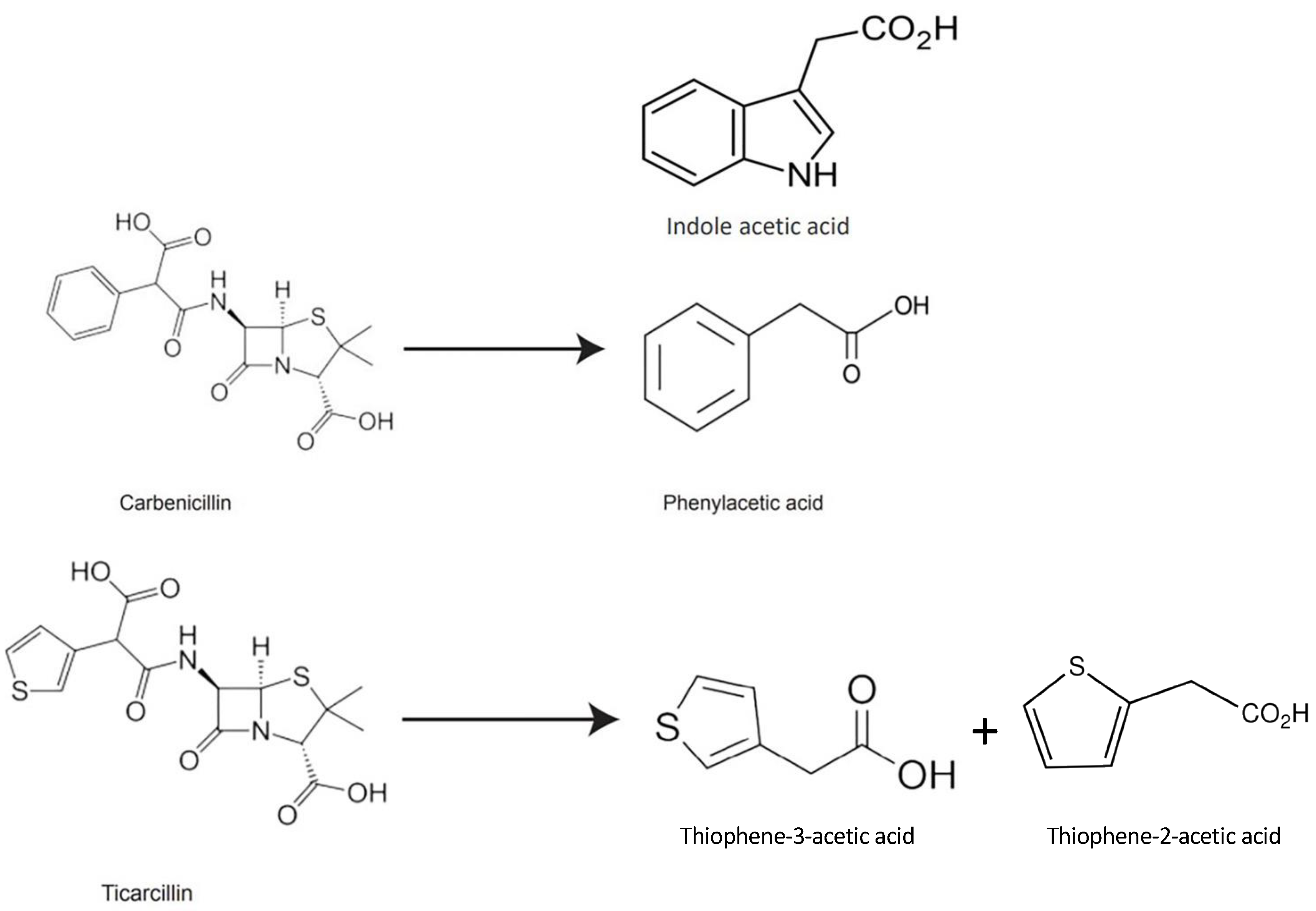
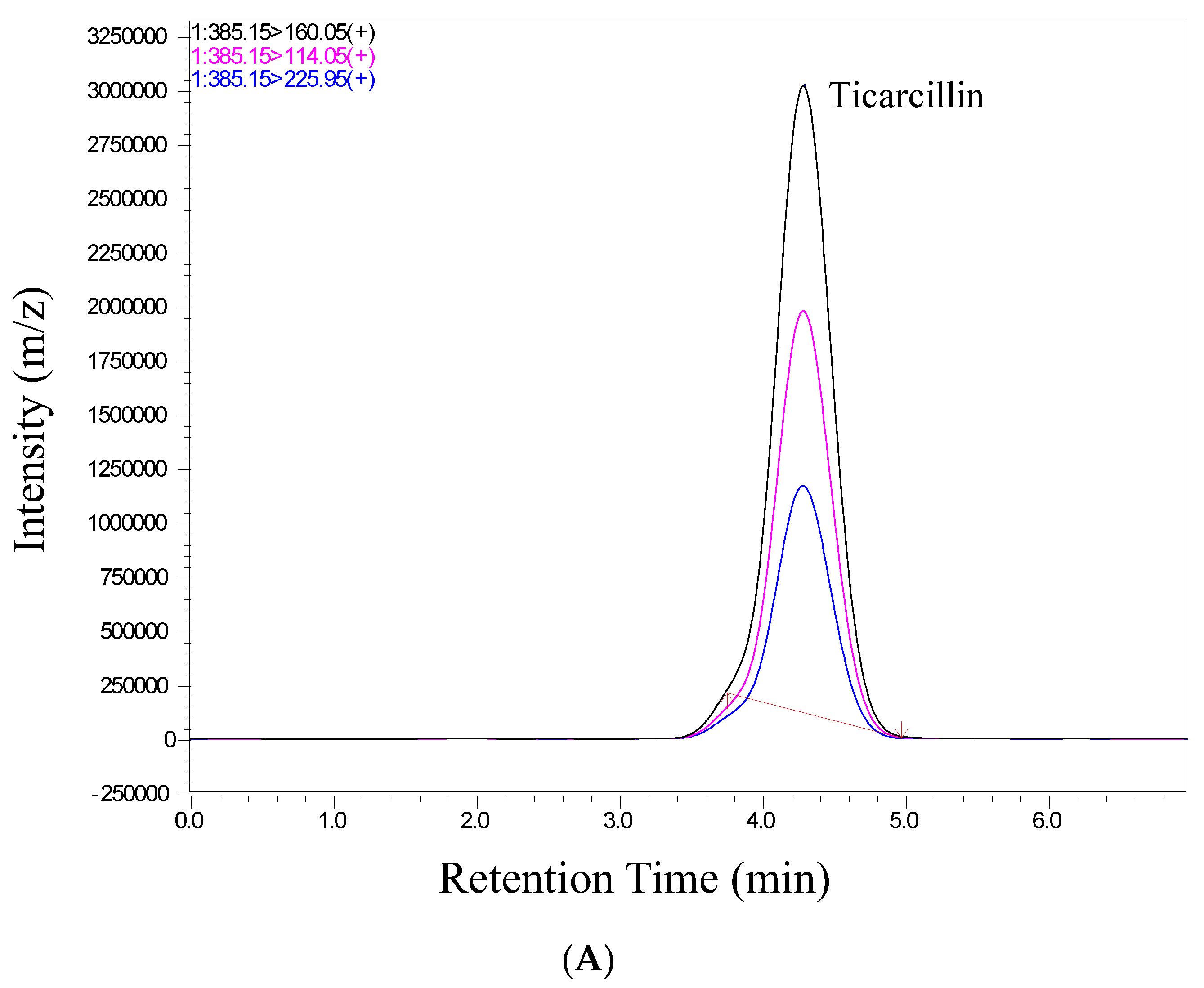
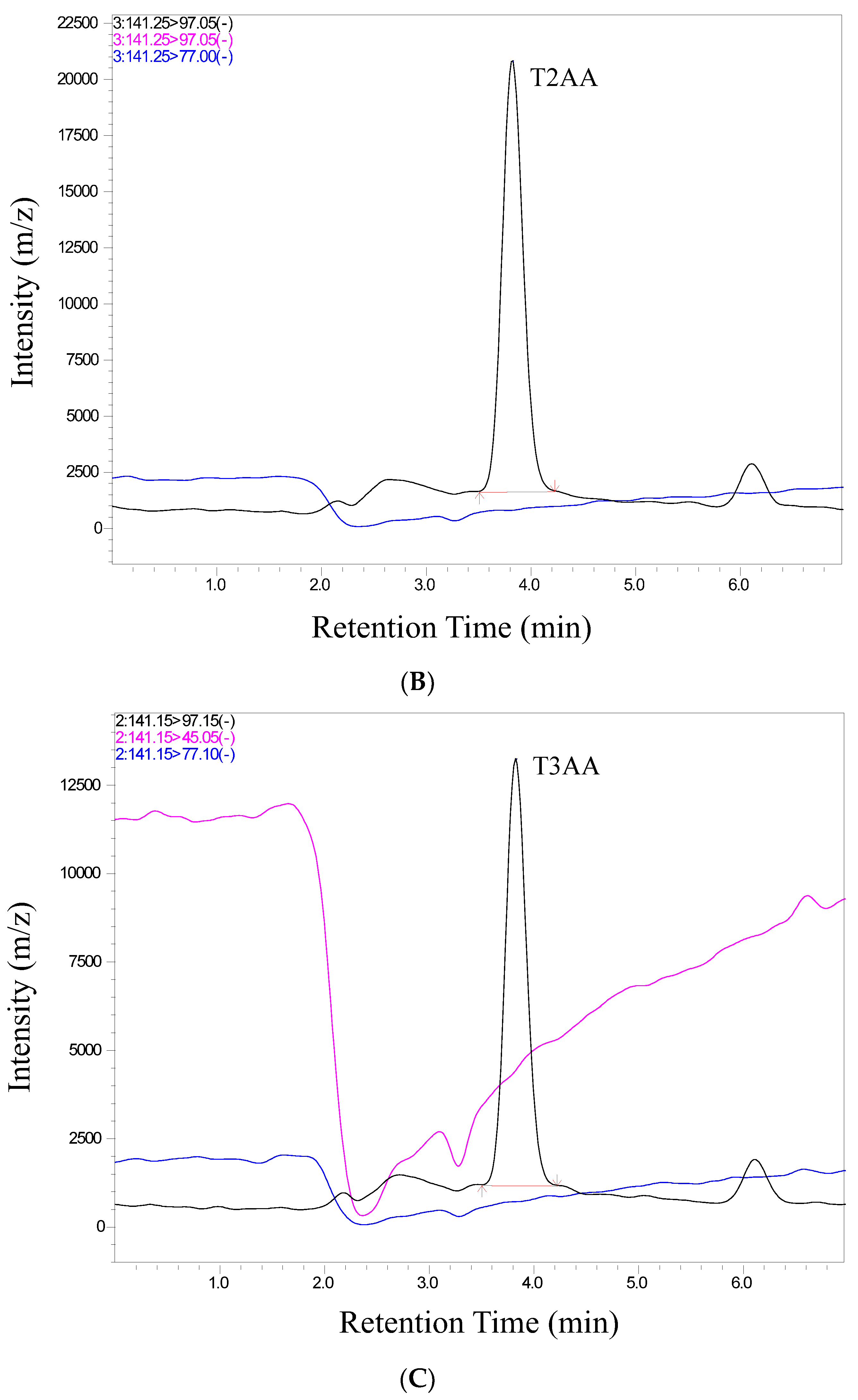
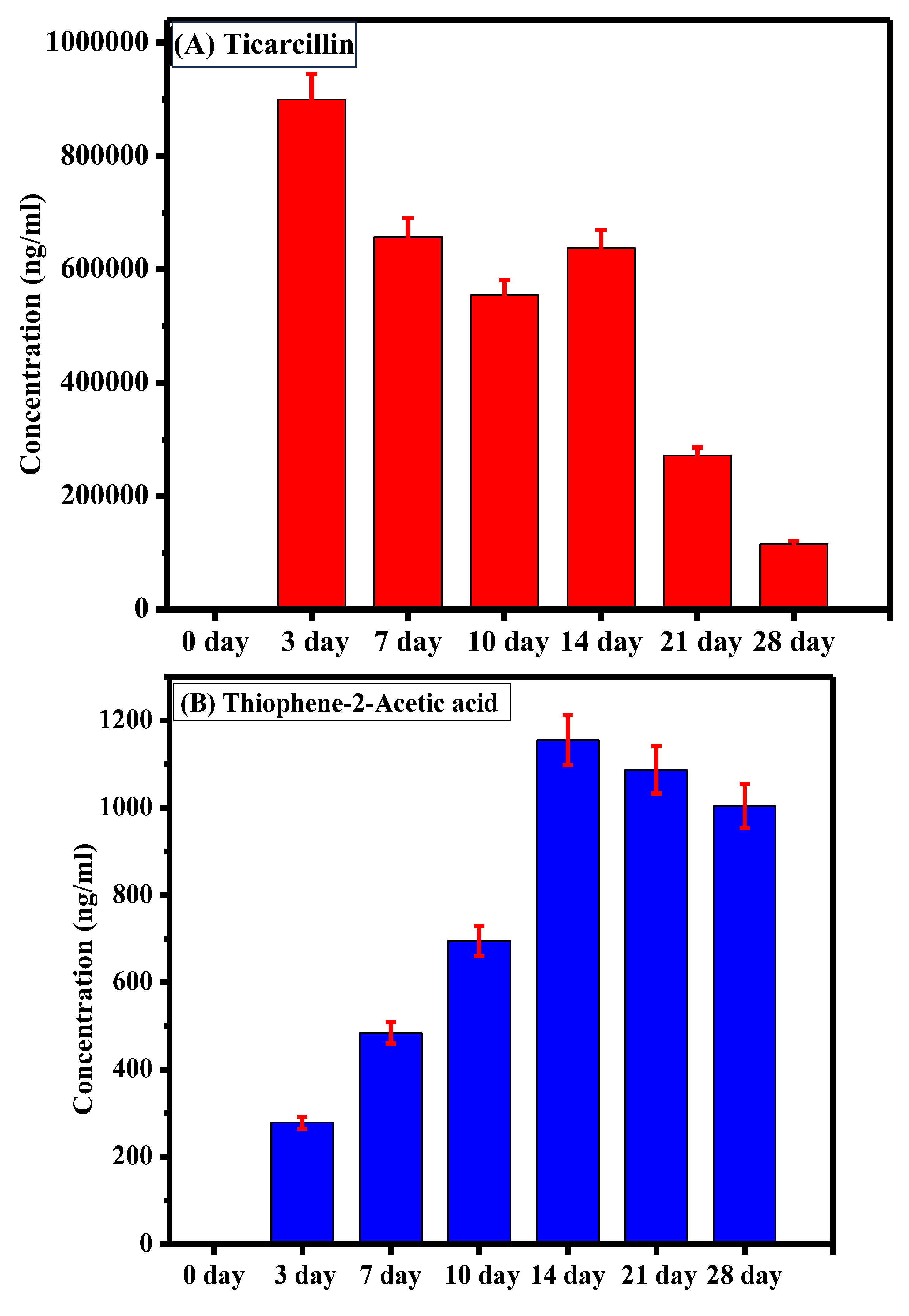
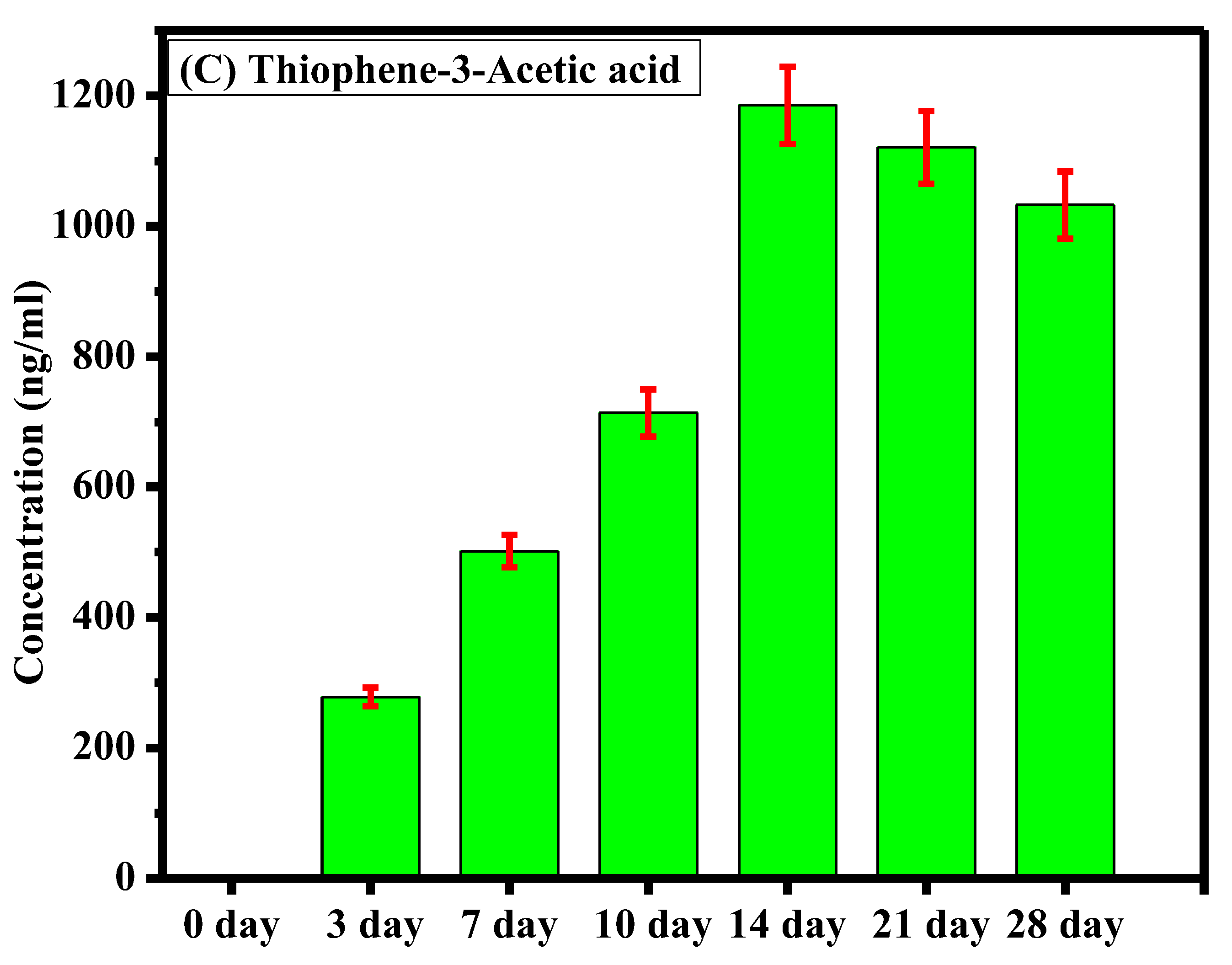
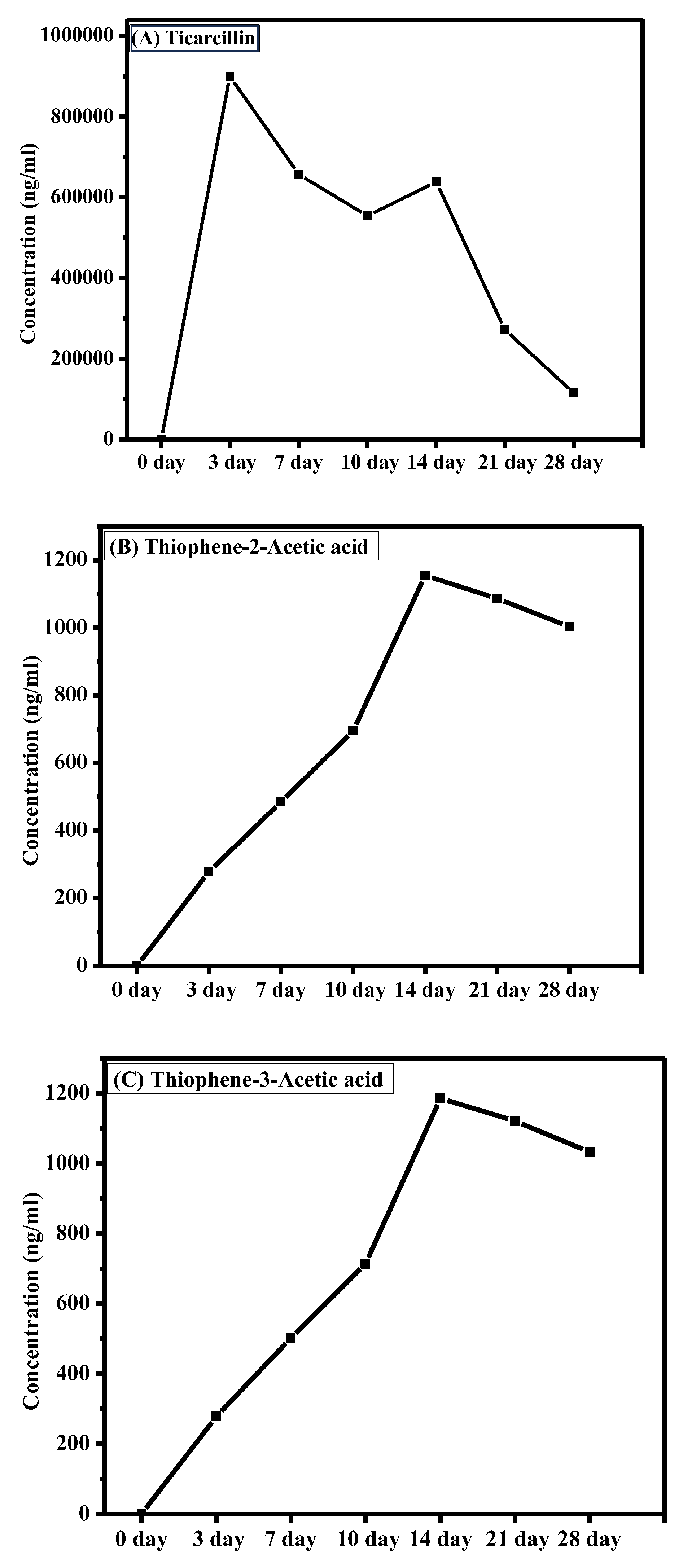
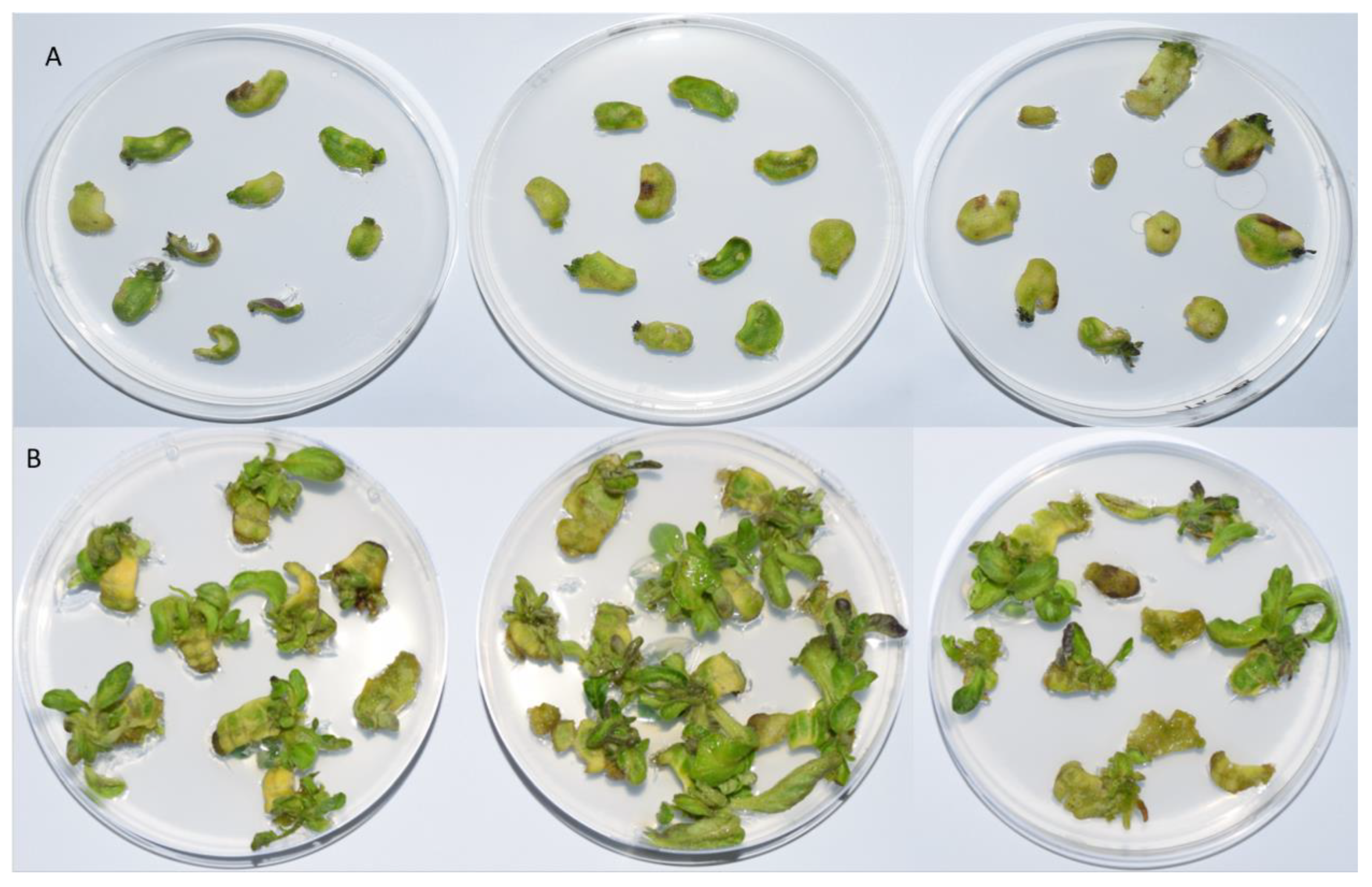
| Compounds | Precursor (Q1) (m/z) | Product (Q3) (m/z) | Dwell Time (ms) | CE (eV) | Q1 Pre Bias (V) | Q3 Pre Bias (V) | Ionization |
|---|---|---|---|---|---|---|---|
| Ticarcillin | 385.15 | 160.05 | 100 | −14 | −20 | −30 | Positive |
| 385.15 | 114.05 | 100 | −36 | −20 | −20 | ||
| 385.15 | 225.95 | 100 | −13 | −20 | −22 | ||
| Thiophene-2- Acetic acid | 141.25 | 45.00 | 100 | 24 | 14 | 11 | Negative |
| 141.25 | 97.05 | 100 | 11 | 14 | 25 | ||
| 141.25 | 77.00 | 100 | 39 | 12 | 20 | ||
| Thiophene-3-Acetic acid | 141.15 | 97.15 | 100 | 11 | 26 | 20 | Negative |
| 141.15 | 45.05 | 100 | 23 | 14 | 12 | ||
| 141.15 | 77.10 | 100 | 34 | 13 | 11 |
| S.No | Compound Name | Quality Control | Concentration (ng/mL) | Intra-day | Inter-day | R2 | LOD (ng/mL) | LOQ (ng/mL) | Linearity Range (ng/mL) | ||
|---|---|---|---|---|---|---|---|---|---|---|---|
| Accuracy % | Precision (% CV) | Accuracy % | Precision (% CV) | ||||||||
| 1 | Ticarcillin | LQC | 500 | 110.1 | 3.2 | 107.00 | 2.9 | 0.9957 | 59.0 | 178.8 | 500 to 3500 |
| MQC | 1000 | 110.9 | 1.9 | 109.5 | 2.2 | ||||||
| HQC | 2500 | 104.4 | 1.3 | 103.6 | 1.2 | ||||||
| 2 | Thiophene-2- Acetic acid | LQC | 500 | 99.7 | 9.1 | 98.6 | 7.4 | 0.9990 | 120.3 | 364.7 | 500 to 3500 |
| MQC | 1000 | 105.8 | 1.9 | 103.9 | 2.2 | ||||||
| HQC | 2500 | 101.7 | 2.1 | 99.7 | 1.8 | ||||||
| 3 | Thiophene-3-Acetic acid | LQC | 500 | 102.9 | 6.6 | 100.7 | 6.5 | 0.9982 | 156.2 | 473.6 | 500 to 3500 |
| MQC | 1000 | 108.0 | 2.7 | 105.5 | 3.1 | ||||||
| HQC | 2500 | 104.5 | 1.7 | 101.7 | 1.9 | ||||||
Disclaimer/Publisher’s Note: The statements, opinions and data contained in all publications are solely those of the individual author(s) and contributor(s) and not of MDPI and/or the editor(s). MDPI and/or the editor(s) disclaim responsibility for any injury to people or property resulting from any ideas, methods, instructions or products referred to in the content. |
© 2024 by the authors. Licensee MDPI, Basel, Switzerland. This article is an open access article distributed under the terms and conditions of the Creative Commons Attribution (CC BY) license (https://creativecommons.org/licenses/by/4.0/).
Share and Cite
Hakeem, M.K.; Elangovan, S.; Rafi, M.; George, S.; Shah, I.; Amiri, K.M.A. Advancing Antibiotic Residue Analysis: LC-MS/MS Methodology for Ticarcillin Degradation Products in Tomato Leaves. Antibiotics 2024, 13, 133. https://doi.org/10.3390/antibiotics13020133
Hakeem MK, Elangovan S, Rafi M, George S, Shah I, Amiri KMA. Advancing Antibiotic Residue Analysis: LC-MS/MS Methodology for Ticarcillin Degradation Products in Tomato Leaves. Antibiotics. 2024; 13(2):133. https://doi.org/10.3390/antibiotics13020133
Chicago/Turabian StyleHakeem, Muhammad K., Sampathkumar Elangovan, Mohammed Rafi, Suja George, Iltaf Shah, and Khaled M. A. Amiri. 2024. "Advancing Antibiotic Residue Analysis: LC-MS/MS Methodology for Ticarcillin Degradation Products in Tomato Leaves" Antibiotics 13, no. 2: 133. https://doi.org/10.3390/antibiotics13020133
APA StyleHakeem, M. K., Elangovan, S., Rafi, M., George, S., Shah, I., & Amiri, K. M. A. (2024). Advancing Antibiotic Residue Analysis: LC-MS/MS Methodology for Ticarcillin Degradation Products in Tomato Leaves. Antibiotics, 13(2), 133. https://doi.org/10.3390/antibiotics13020133








